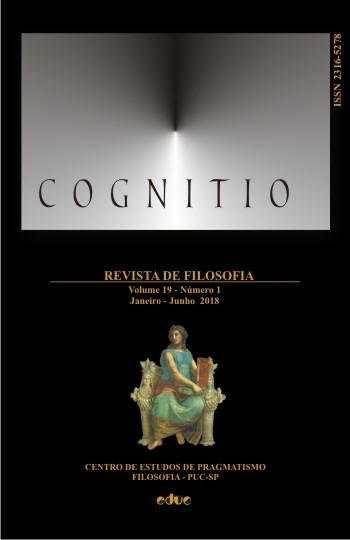As categorias sob disfarce: uma especificação categorialógica da consideração de D. Dilworth da proveniência das categorias de Peirce em Schiller
DOI:
https://doi.org/10.23925/2316-5278.2018v19i1p160-178Palavras-chave:
Estética, Arquitetônica, Belo, Categorias, Cenoscopia, Experiência comum, Friedrich Schiller, História, Kant, Lógica da determinação, Metafisica, Modalidade, Ciência normativa, Normatividade, Processos psíquicos.Resumo
Uma análise metodologicamente correta da profundidade e escopo da influência de Schiller sobre o pensamento maduro de Peirce requer três passos: (i) uma análise preliminar das passagens que poderiam sustentar a hipótese de uma influência prolongada e, assim, poderá também indicar seus vetores sistemáticos. No caso de tal análise dar resultados positivos, tornar-se-ia (ii) necessário explorar as juvenilia que documentam a recepção inicial de Peirce de Schiller, para (iii) tentar identificar aquelas ideias que tornam inteligibilidade à re-emergência de Schiller no pensamento de Peirce após 1900. Com base nos resultados que nossa contextualização arquitetônica preliminar das reminiscências de Peirce de seu estudo juvenil das Cartas Estéticas resultaram em um artigo duplo. O presente artigo foca nos segundo e terceiro passos. Logo, nosso propósito é mostrar que a tríplice aparência das categorias de Schiller fazem em seu disfarce – ora como momentos de determinação lógica, ora como estados mentais coletivo e individual de mentes socializadas moldadas pelas relações de unidades psíquicas elementares, e ora como estágios de processos históricos – primeiro agindo como o catalizador para o entendimento inicial de Peirce das deficiências da categoriologia de Kant e, consequentemente, foi ‘fadado’ à re-emergência posterior em consideração a determinar desafios arquitetônicos que Peirce encontrou-se confrontado enquanto trabalhava no redesenho da cenoscopia das ciências filosóficas nos anos de 1900 a 1903. A influência de Schiller exercida sobre Peirce, portanto, origina em sua prefiguração do conceito de Peirce de categorialidade e a coerência dos usos arquitetônicos que ela permite, em especial, como um meio para a estratificação prescisiva dos componentes – fenomenal, normativa e metafísico-entelequial –da experiência comum e os modos de racionalidade ali incorporadas.Downloads
Publicado
2018-09-06
Como Citar
Topa, A. (2018). As categorias sob disfarce: uma especificação categorialógica da consideração de D. Dilworth da proveniência das categorias de Peirce em Schiller. Cognitio: Revista De Filosofia, 19(1), 160–178. https://doi.org/10.23925/2316-5278.2018v19i1p160-178
Edição
Seção
Artigos Cognitio









